Sets and Functions
The concept of set is fundamental in all branches of mathematics. It is widely used in developing relationships and functions , logic theory , sequence and series , geometry , probability theory etc. Collecting items in our daily life such as pack of cards, a group of people or crowds, cricket teams etc. are called sets.
In mathematical language , collection of well - defined objects is called set. And those things which are contained in a set or follow any rule , then that object is called a member or element of that set . The sets are generally represented by the English alphabets of A, B, C, D ….. etc . and their elements or members are represented by a, b, c, d …… etc. If any set A has been given which has one element a So we can say that a ∈ A
And when any set A has been given there is no element a , then we can say that a ∉ A
Example :- ( ⅰ ) Set of all vowels in english alphabet.
( ⅱ ) Set of rivers in india .
( ⅲ ) Set of points on any circle .
( ⅳ ) Set of multiples of 3.
( ⅴ ) Set of factors of 12.
( ⅵ ) Set of even numbers .
Representation of Sets :-
The representation of sets are used to two methods.
1. Tabular method or roster form : -
In this method, we write all the elements or members of the set by commas ( , ) in separate curly { } brackets. This method is called Tabular method or roster form.
Note : - An element of the set is not written more than once.
Thus, set {1, 5, 1, 1, 4, 5, 6} is written as {1, 4, 5, 6}.
Example 1 . Write the set of vowels of the English alphabet in the roster form.
Sol :- By roster form , the set of vowels of the English alphabet A = { a , e , i , o , u }.
2. Set Builder form :-
In this method, instead of all the elements or members of the set, one denotes a particular quality which is satisfied with each of its elements. This method is called set builder form. This method is used when we have more than number of sets. In this, all the elements of the set are represented by a variable x and the special properties of the elements are expressed by P (x).
A = { x : P(x) } Or A = { x | x has the property of P( x ) } and read it as “A is the set of all elements x such that x has the property P”. The symbol ‘:’ or ‘|’ stands for ‘such that’.
Where , P( x ) has such property ,which is satisfied by every x .
Example 2. By set builder form , Write the set of all states of India beginning with the letter A .
Sol :- By set builder form , Let A = { x : x is the all states of India beginning with the letter A }.
Types of Sets :-
These are of following types which is given below :-
1. Empty or Null set :-
When there is no element in any set , then such set is called an empty or null set. It is denoted by φ Or { }.
Example 3. ( ⅰ ) The set of natural numbers less than 1 .It is an example of empty set.
(ii) The set of odd numbers divisible by 2 is a null set.
2. Singleton Set :-
When a set contains only one element or member , then such set is called singleton set.
Example 4. The set of the smallest even number 2 is an example of a singleton set.
Sol :- A = { 2 }
3. Finite Set :-
Such sets , in which the number of elements has been finite or whose counting can be easily calculated, this set is called a finite set.
Example 5. Each of the following given sets is a finite set : -
(ⅰ) What will be the set of prime numbers smaller than 12 ?
Sol : - A = set of prime numbers smaller than 12 = { 2, 3, 5, 7, 11 }
(ⅱ) Explain the set of vowels in the English alphabet.
Sol : - B = set of vowels in English alphabet = { a, e, i, o, u }
Cardinal number of a Finite set :-
The number of different elements in a finite set S is called the cardinal number of S. and it is represented by n (S).
Example 6. If S = = { 2 , 4 , 6 , 8 , 10 } , then find the cardinal number of S.
Sol :- Given , S = = { 2 , 4 , 6 , 8 , 10 }
Since set S contains total number of elements 5 .So , the cardinal number of S = n( S ) = 5 .
4. Infinite Set : -
Such set in which the number of elements has been infinite ( unlimited ) or which can not be easily calculated, this set is called an infinite set.
Example 7. The set of all natural numbers is an infinite set or not ?
Sol : - A set of all natural numbers = { 1, 2, 3, 4, 5 ……….. }
Therefore, the set of all natural numbers is an infinite set.
Equal set : -
When there are two non-empty set A and B. If all the elements of both sets are given in one another, then set A and B are called equal sets.It is represented by A = B iff x ∈ A ⇒ x ∈ B and x ∈ B ⇒ x ∈ A .To indicate that two sets A and B are not equal, we will write A ≠ B.
Example 8. If A = { 2, 1, 4, 3 } and B = { 1, 2, 3, 4 } are equal sets or not?
Sol : - A = { 2, 1, 4, 3 } and B = { 1, 2, 3, 4 } will be the equal set because elements of both of these are given in each other. Therefore A and B are the equal sets.
Equivalent set :-
When the cardinal number of any two finite sets are equal to n (A) = n (B), then both sets are called equivalent sets.
In any two equivalent sets, the number of elements is same, it is not necessary that the elements of both of them are the same. The number of elements in two equal sets may or may not be the same. The symbol ‘ ~ ’ is used to denote equivalence. Thus, A ~ B is read as “A is equivalent to B”.
Example 8. If A = { 1, 3, 5 } and B = { 2, 4, 6 } , then will both sets have equivalent sets?
Sol : - Since we know that if the number of elements in any of the two sets is equal , then those sets are called equivalent sets.
Here, n (A) = 3, n (B) = 3 ⇒ A ∼ B
Hence both sets A and B are equivalent sets.
Subset of a Set : -
When two sets A and B are given. If each element of set B is also an element of set A , then set B is called a subset of A . It is represented by B ⊆ A or A ⊇ B.
In A ⊇ B , we read ' Set A is super set of set B '.
Note : - ( ⅰ ) Each set is a subset of itself.
( ⅱ ) When the number of elements in any set is n , then the number of its proper subsets is 2n - 2.
Example 9. If A = { 1, 3, 5 } and B = { 1, 2, 3, 4, 5, 6 } are any two sets , what will set A be the subset of set B ?
Sol : - Given , A = { 1, 3, 5 } and B = { 1, 2, 3, 4, 5, 6 }
Since all elements of set A { 1, 3, 5 } are included in the elements of set B . So , set A will be the subset of set B
i.e. A ⊆ B
Example 10. If A = { 1, 2, 3, 4, 5, 6 } and B = { 1, 3, 5 } are any two sets , then what will set A be super set of set B?
Sol : - Given , A = { 1, 2, 3, 4, 5, 6 } and B = { 1, 3, 5 }
Since all the elements of set B { 1 , 3 , 5 } are contained in the elements of set A . So , set B will be the subset of set A and set A will be the super set of set B.
i.e. A ⊇ B
Proper subset of a set : -
If two sets A and B are given. In this every element of set A is also the element of set B , but if any one of the elements of set B is not an element of set A , then set A is called the proper set of set B. It is generally denoted by A ⊂ B .
Example 11. If A = { 1, 2, 3, 4, 5, 6 } and B = { 1, 2, 3, 5 } are any two sets , then what will set A be the proper set of set B ?
Sol : - Given, A = { 1, 2, 3, 4, 5, 6 } and B = { 1, 2, 3, 5 }
Since the element { 1, 2, 3, 4, 5, 6 } in set A are given . while the element { 4, 6 } of set A in set B has no given . Therefore, set B is the proper set of set A.
i.e. B ⊂ A
Universal set : -
Such a set in which all elements of all given subsets are included. Or The super set of every given set is called the universal set . It is represented by U .
Example 12. If A = { 3, 4, 5, 6 } and B = { 1, 2, 5 } are any two sets , then what will A ∪ B ?
Sol : - Given , A = { 3, 4, 5, 6 } and B = { 1, 2, 5 }
∴ A ∪ B = { 1, 2, 3, 4, 5, 6 }
Power set : -
All elements of a set can also be some sets. This type of set is called a set of sets.
The set of all subsets of a given set A is called the power set of A and it is represented by P (A).
Note : - (ⅰ) Each set is a subset of itself.
(ⅱ) If the number of elements in a set is n , then the number of elements in the power set is 2n .
Example 13. Set A = { φ , {1}, {2}, {3}, {4, 5} } is a set , then what will be the value of P (A)?
Sol : - Given , set A = { &phi ;, {1}, {2}, {3}, {4, 5} }
Then , P (A) = { φ , {1}, {2}, {3}, {4, 5}, A }
Comparable set : -
If there are two sets A and B , which are A ⊂ B or B ⊂ A , then the sets A and B are called comparable sets. If neither A ⊂ B and nor B ⊂ A , then A and B are called non - comparable sets.
Example 14. If A = { 1, 3, 5 } and B = { 1, 2, 3, 4, 5, 6 } are any two sets , then set A and B will be comparable sets or not ?
Sol : - Given , A = { 1, 3, 5 } and B = { 1, 2, 3, 4, 5, 6 }
Since all the elements of set A are in set B. Therefore we can say that set A is the subset of set B. i.e. , A ⊂ B
Hence , set A and set B will be comparable sets.
Venn diagrams : -
When different types of sets are geometrically representation on certain operations , such as diagrams are called Venn diagrams.These are represented by figures. These are represented by the universal set inside a rectangular shape and the other set or subsets are represented by interiors of circles.
Examples of certain relationships between sets by Venn diagrams : -
1. If U is a set of English alphabet letters and is a set of vowels of alphabet , then the relation between these two sets is shown in the diagram given below. fig. (a)
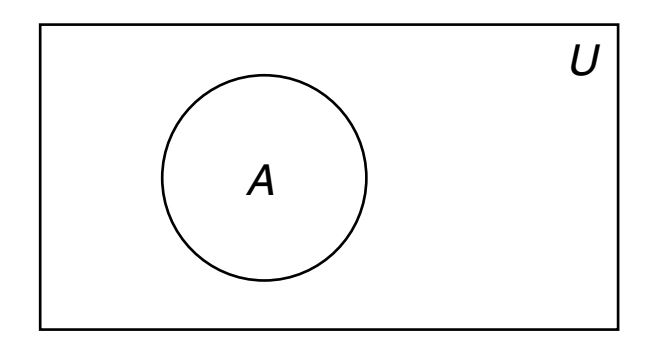
2. If A ⊂ B and A ≠ B, then A and B can be represented by any one of the diagrams given below.
fig. (b) and fig. (c)
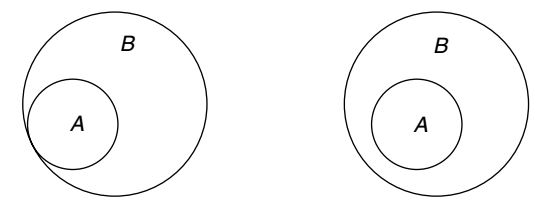
3. If A and B are not comparable , then either A or B is not a subset of another, then the relation between these two sets can be represented by any diagram. fig . (d) and fig . (e)
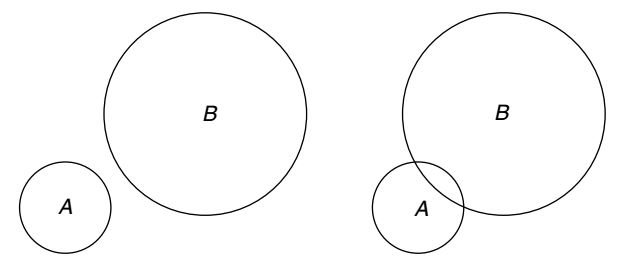
4. If A = { 1, 2, 3, 4 } and B = { 5, 6, 7 } , then set A and B are disjoint. They are shown in the given figure below by Venn diagram. fig (f)

Complementary set : -
Let U is a universal set and A is the proper set of universal set U.Let us now constitute another set consisting of all the elements of U not in A. If the set which is obtained when subtracting all the elements of a given set from any of the elements of the universal set U , then it is called Complementary set . It is represented by A c or A '.
A c = U - A = { x : x ∊ U , x ∉ A }
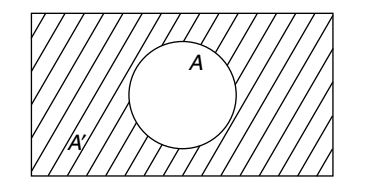
Note : - (ⅰ) Since A ⊂ A, then A ' = φ
(ⅱ) Complement of the complement of a set is the set itself. i.e. , (A′ )′ = A .
Example 15. If A = { 1, 3, 5 } and U = { 1, 2, 3, 4, 5, 6 } , then find the value of A'.
Sol : - Given , A = { 1, 3, 5 } and U = { 1, 2, 3, 4, 5, 6 }
∴ A' = U - A = { 2, 4, 6 }
Operations on Sets :-
1. Union of Sets :-
Let two sets A and B are given. In the union of set A and B , either the elements of set A or the elements of set B or all the elements of both the set A and B are present , then this type of union is called the union of the set.The union of two sets A and B is denoted by 'A ∪ B 'and it is read ' A union B '.
In Symbolically form , A ∪ B = { x : either x ∊ A or x ∊ B }
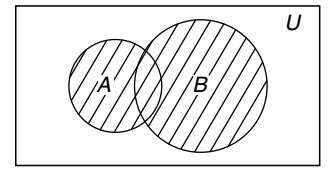
Example 16. If A = { 1, 3, 5 } and B = { 1, 2, 4, 6, 7 }, then what will be the value of A ∪ B ?
Sol : - Here , A = { 1, 3, 5 } and B = { 1, 2, 4, 6, 7 }
∴ A ∪ B = { 1, 2, 3, 4, 5, 6, 7 }
2. Intersection of Sets :-
Assume that A and B are two sets given. The elements of A and B which are present in both. Or such elements that are common in both, this type of intersection is called intersection of sets. It is denoted by 'A ∩ B ' and it is read as ' A intersection B ' .
In Symbolically form , A ∩ B = { x : x ∊ A x ∊ B}
Note : - ⇒ x ∊ A ∩ B ⇔ x ∊ A and x ∊ B
⇒ x ∉ A ∩ B ⇔ x ∉ A or x ∉ B
⇒ A ∩ B ⊆ A and A ∩ B ⊆ B
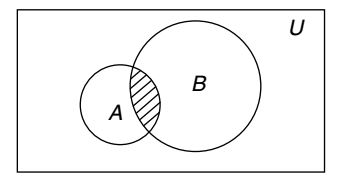
Example 17. If A = { 1, 3, 5 } and B = { 1, 2, 4, 5, 6, 7 } , then what will be the value of A ∩ B ?
Sol : - Here , A = { 1, 3, 5 } and B = { 1, 2, 4, 5, 6, 7 }
∴ A ∩ B = { 1, 5 }
Disjoint Sets :-
If there is no common element in any two sets A and B. That is , A ∩ B = φ , then the sets A and B are called disjoint sets.
Example 18. If A = { 1, 3, 5 } and B = { 2, 4, 6, 8 }, then what will be the value of A ∩ B?
Sol : - Here, A = {1, 3, 5} and B = {2, 4, 6, 8}
∴ A ∩ B = φ

3. Difference of Sets :-
Let A and B are given two sets. Those elements which are in set A but not in Set B, this type of set is called the difference of sets. It is represented by A - B and it is read as ' A difference B '.
In symbolically form , A - B = { x : x ∊ A x ∉ B }
Similarly , B - A = { x : x ∊ B x ∉ A }
In General , A - B ≠ B - A
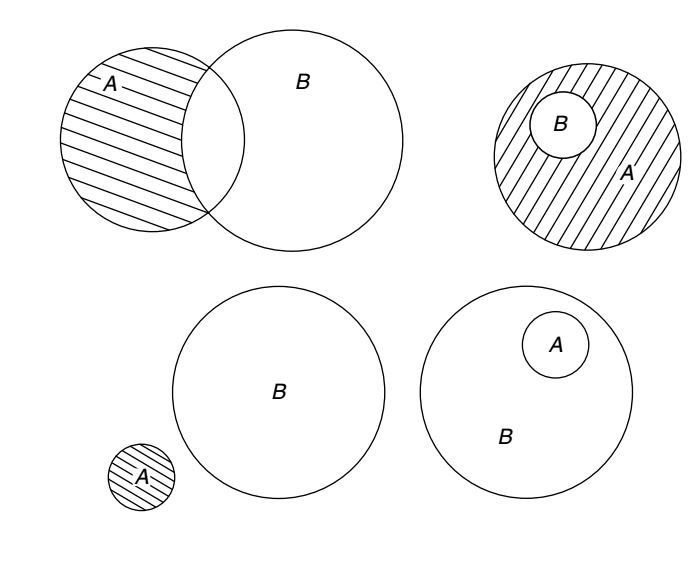
Example 19. If A = { a, b, c, d } and B = { f, b, d, g }, then what will be the value of A - B ?
Sol : - Here , A = { 1, 3, 5 } and B = { f, b, d, g }
∴ A - B = { a, b, c, d } - { f, b, d, g } = { a, c } .
Applications of sets : -
1. If any set S is the number of finite elements , then we denote by n ( S ) the number of elements of S.
Example 20. If U = { 1, 3, 5, 7 } , then what will be n ( U ) ?
Sol : - Given , U = { 1, 3, 5, 7 }
Then , n ( U ) = 4
2. For any two sets A and B, with finite number of elements, we have the following formula :
| n (A ∪ B) = n (A) + n (B) - n (A ∩ B) |
then , what will be the value of n (A ∩ B) ?
Sol : - Given , n (A ∪ B) = 30 , n (A) = 15 , n (B) = 21
⇒ 30 = 15 + 21 - n (A ∩ B)
⇒ 30 = 36 - n (A ∩ B) ⇒ n (A ∩ B) = 36 - 30 = 6
∴ n (A ∩ B) = 6
3. If A and B are any two disjoint sets , then
| n (A ∪ B) = n (A) + n (B) |
Ordered pair : -
Let A and B are the two non - empty set. If a ∊ A and b ∊ B , then the form of an element (a , b) is called ordered pair. Where a is the first element and b is considered to be the second element. It is clear from this definition that -
| 1. (a , b) ≠ (b , a) 2. If only if a = c and b = d. Then there will be (a , b) = (c , d). |
Example 22 . If ( p - 3 , q + 2 ) = ( 4 , 5 ) , find the value of p and q .
Sol : - Given that , ( p - 3 , q + 2 ) = ( 4 , 5 )
⇒ p - 3 = 4 and q + 2 = 5
Then p = 4 + 3 and q = 5 - 2 ⇒ p = 7 and q = 3 .
Equality of two ordered pairs :-
Two ordered pairs (a , b) and (c , d) are said to be equal if and only if a = c and b = d.
For example, the ordered pair (2 , 4) and (2 , 4) are equal , while the ordered pair (2 , 4) and (4 , 2) are not equal or different . The distinction between set { 2 , 4 } and the ordered pair (2 , 4) must be noted carefully. We have {2, 4} is equal to {4, 2} but (2, 4) is not equal to (4, 2).
Cartesian Product of Sets : -
Let us consider non - empty set A and B are given .The set of all ordered pairs (a , b) is called the Cartesian product of sets. Cartesian product of sets A and B is represented by A x B and it is read as ' A cross B '.
| In symbolically form , A x B = {(a , b) : a ∊ A and b ∊ B} |
Example 23. If A = { 1, 3, 5 }, B = { a, b }, then find the value of A x B and B x A.
Sol : - A x B = { (1 , a) , (3 , a) , (5 , a) , (1 , b) , (3 , b) , (5 , b) }
B x A = { (a , 1) , (a , 3) , (a , 5) , (b , 1) , (b , 3) , (b , 5) }
Thus , if A ≠ B , then A x B ≠ B x A .
Properties of Complementary Sets :-
| ( ⅰ ) φ = U' ( ⅱ ) φ' = U ( ⅲ ) (A')' = A ( ⅳ ) A ∪ A' = U ( ⅴ ) A ∩ A' = φ |
De -Morgan's Laws :-
Let A and B are any two sets given , then
| ( ⅰ ) ( A ∪ B )' = A' ∩ B' ( ⅱ ) ( A ∩ B )' = A' ∪ B' ( ⅲ ) (A')' = A ( ⅳ ) A - ( B ∪ C ) = ( A - B ) ∩ ( A - C ) ( ⅴ ) A - ( B ∩ C ) = ( A - B ) ∪ ( A - C ) |
Distributive Laws :-
If A , B and C are three sets given , then
| ( ⅰ ) A ∩ ( B ∪ C ) = ( A ∩ B ) ∪ ( A ∩ C ) ( ⅱ ) A ∪ ( B ∩ C ) = ( A ∪ B ) ∩ ( A ∪ C ) |
Example 24. If U = {a, b, c, d, e, f}, A = {a, b, c}, B = {c, d, e, f}, C = {c, d, e}, find (A ∩ B) ∪ (A ∩ C).
Sol :- A ∩ B = {a, b, c} ∩ {c, d, e, f}
A ∩ B = { c }
A ∩ C = { a, b, c } ∩ { c, d, e }
A ∩ C = { c }
∴ (A ∩ B) ∪ (A ∩ C) = { c }.
Example 25. In a survey of a town, it was found that 65% of the people surveyed watch the news on T.V. 40% read a newspaper and 25% read a newspaper and watch the news on T.V. What percent of the people surveyed neither watch the news on T.V. nor read a newspaper?
Sol :- Required percentage = 100 – (40 + 25 + 15)
Required percentage = 100 – 80 = 20%
Example 26.There are 80 families in a small extension area. 20 percent of these families own a car each. 50 percent of the remaining families own a motor cycle each. How many families in that extension do not own any vehicle?
Sol :- Given in the question,
| 20% of 80 = 20 × | = 16 | |
| 100 |
| Remaining families of 50% = (80 – 16) × | = 32 | |
| 100 |
Hence , Number of families not owning any vehicle is 32.